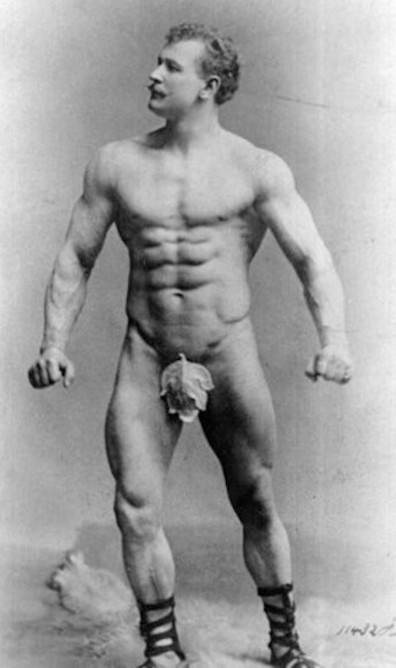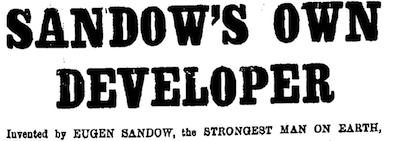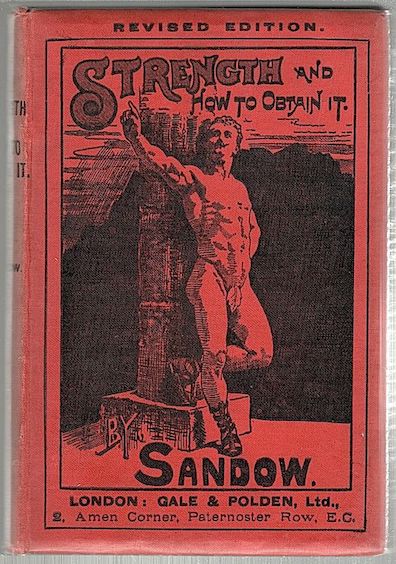Friedrich Wilhelm Müller, born in Prussia in 1867, gave
himself the stage name Eugen Sandow when he began performing
in European circuses in the 1880s. In addition to performing
staggering feats of strength, he adopted poses that would
highlight particular aspects of his musculature, as
professional bodybuilders do today. In the 1890s Sandow opened
schools that taught exercise routines, healthy diets, and
weight training. He published a monthly magazine called Physical
Culture starting in 1898, wrote several books (which
included charts prescribing amounts of weight and numbers of
repetitions), invented new kinds of exercise equipment, and
championed isometric exercises (merely tightening and
releasing muscle groups) as a complement to weight-lifting.
In addition to performing internationally, Sandow organized
bodybuilding competitions, trained soldiers, and served for a
while as a personal trainer to King George V. In May 1898 he
delivered a run of spectacular performances in Dublin's Empire
Palace Theatre. More than 1,300 people came on the first night
to see him effortlessly lift enormous dumbbells, throw human
beings around like beanbags, rip three decks of playing cards
stacked on top of one another, and lift up a platform
containing a piano while the pianist continued playing on it.
Sandow enjoyed a sky-high reputation in Ireland for many years
after the 1898 tour, and sold many copies of his books as well
as the Sandow Developer, a pulley system for dumbbells that
anticipated modern weight-lifting machines. A good account of
the Irish Sandow craze can be found at www.theirishstory.com.
Sandow's most famous book, Strength and How to Obtain It
(1897)—Joyce got the title slightly wrong—supplied a chart for
recording measurements of particular muscle groups, so that
the practitioner could track their growing size. Ithaca
observes that these "indoor exercises . . . designed
particularly for commercial men engaged in sedentary
occupations, were to be made with mental concentration in
front of a mirror so as to bring into play the various
families of muscles and produce successively a pleasant
rigidity, a more pleasant relaxation and the most pleasant
repristination of juvenile agility." Later, when it details
the contents of Bloom's desk drawer, the chapter mentions "a
chart of the measurements of Leopold Bloom compiled before,
during and after 2 months' consecutive use of Sandow-Whiteley's
pulley exerciser (men's 15/-, athlete's 20/-) viz.
chest 28 in and 29 1/2 in, biceps 9 in and 10 in, forearm 8
1/2 in and 9 in, thigh 10 in and 12 in, calf 11 in and 12 in."
Alas, like many later 20th and 21st century individuals who
have purchased exercise advice and exercise equipment, Bloom
suffered a lapse of enthusiasm after his two months of
faithful adherence. Ithaca notes that his Sandow's
routines were "formerly intermittently practised, subsequently
abandoned." In Calypso, his brief plunge into black
gloom on Dorset Street
makes him resolve to improve his physical conditioning:
"Morning mouth bad images. Got up wrong side of the bed. Must
begin again those Sandow's exercises." In Circe,
a near encounter with a tram causes him to renew the
resolution: "Close shave that but cured the stitch. Must
take up Sandow's exercises again."
Sandow advocated what he called the "Grecian ideal" of male
beauty, shaping his own body to measurements of muscles that
he took from statues in museums. Bloom's interest in the
Sandow ideal is clearly of a piece with his admiration for the
standards of beauty embodied in Greek
statues, both male and female. His mimetic desire for
the one and sublimated sexual desire for the other merge with
any purer aesthetic appreciations he may have, making his
response to this great art form as much "kinetic" as "static,"
in the terms that Stephen propounds in Part 5 of A
Portrait of the Artist.
[2019] Bloom's conscious thoughts about Sandow are limited to
desiring physical strength, but his mimetic attraction to this
brilliant self-promoter may express professional envy as well.
As Vike Martina Plock observes in Joyce, Medicine, and
Modernity (UP of Florida, 2010), "Both physically and
commercially Sandow has achieved what Leopold Bloom can only
dream of: physical superiority and professional success in
advertising" (119). Sandow's books and magazine, his
theatrical triumphs, his classes, his exercise products, his
marketing of his services as a consultant, his modeling for
photographs: Bloom would count himself fortunate to achieve
any one of these commercial successes.
In a personal communication, fitness trainer and writer
Andrew Heffernan adds several other interesting pieces of
information. Sandow completely changed the look of
weight-lifters: "Prior to him, strongmen were thick-waisted
beer-guzzling bears." In order to accentuate the resemblance
to ancient statues, he would cover himself in white powder
that gave his body the appearance of having been carved from
marble. And Sandow "was—and remains—the model for the trophy
given annually to the winner of the Mr. Olympia
contest—bodybuilding's top prize." Heffernan's photograph of
one of these trophies appears here.




